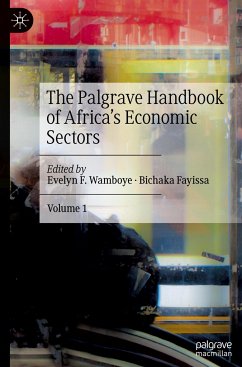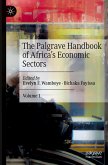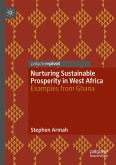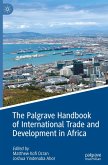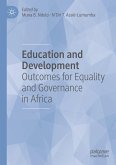The Palgrave Handbook of Africa's Economic Sectors
Herausgegeben:Wamboye, Evelyn F.; Fayissa, Bichaka
The Palgrave Handbook of Africa's Economic Sectors
Herausgegeben:Wamboye, Evelyn F.; Fayissa, Bichaka
- Gebundenes Buch
- Merkliste
- Auf die Merkliste
- Bewerten Bewerten
- Teilen
- Produkt teilen
- Produkterinnerung
- Produkterinnerung
This handbook provides a reference resource to showcase insightful and nuanced perspectives on Africa's agriculture, industry, services, and manufacturing sectors; factors affecting the sectors' competitiveness; and the sectors' contribution to employment, economic growth, and sustainable development. It also addresses the potential benefits that the sectors could harness from the planned Continental Free Trade Area (CFTA), and in particular how CFTA could increase the efficiency and competitiveness of these sectors. This book provides evidence-based holistic analyses of the past and current…mehr
Andere Kunden interessierten sich auch für
![The Palgrave Handbook of Africa's Economic Sectors The Palgrave Handbook of Africa's Economic Sectors]() The Palgrave Handbook of Africa's Economic Sectors109,99 €
The Palgrave Handbook of Africa's Economic Sectors109,99 €![Nurturing Sustainable Prosperity in West Africa Nurturing Sustainable Prosperity in West Africa]() Stephen ArmahNurturing Sustainable Prosperity in West Africa43,99 €
Stephen ArmahNurturing Sustainable Prosperity in West Africa43,99 €![The Palgrave Handbook of International Trade and Development in Africa The Palgrave Handbook of International Trade and Development in Africa]() The Palgrave Handbook of International Trade and Development in Africa216,99 €
The Palgrave Handbook of International Trade and Development in Africa216,99 €![The Primacy of Regime Survival The Primacy of Regime Survival]() Mark SimpsonThe Primacy of Regime Survival30,99 €
Mark SimpsonThe Primacy of Regime Survival30,99 €![Education and Development Education and Development]() Education and Development123,99 €
Education and Development123,99 €![The Primacy of Regime Survival The Primacy of Regime Survival]() Mark SimpsonThe Primacy of Regime Survival30,99 €
Mark SimpsonThe Primacy of Regime Survival30,99 €![The Palgrave Handbook of Comparative Economics The Palgrave Handbook of Comparative Economics]() The Palgrave Handbook of Comparative Economics217,99 €
The Palgrave Handbook of Comparative Economics217,99 €-
-
-
This handbook provides a reference resource to showcase insightful and nuanced perspectives on Africa's agriculture, industry, services, and manufacturing sectors; factors affecting the sectors' competitiveness; and the sectors' contribution to employment, economic growth, and sustainable development. It also addresses the potential benefits that the sectors could harness from the planned Continental Free Trade Area (CFTA), and in particular how CFTA could increase the efficiency and competitiveness of these sectors.
This book provides evidence-based holistic analyses of the past and current state of Africa's economic sectors, with a strong emphasis on tangible and specific policy recommendations for the purpose of enhancing future economic growth, employment, and sustainable development of the continent. It also assesses the impact of the first-ever Continental Free Trade Area in Africa, and its potential implications for Africa's integration into regional and global economy and competitiveness relative to other fast developing economies (such as those in Asia). This handbook gives an in-depth analysis of fundamental domestic factors that have relevance on the sectors' expansion and growth and their contributions to employment, economic growth, and sustainable development in Africa with differential effects across the continent.
Hinweis: Dieser Artikel kann nur an eine deutsche Lieferadresse ausgeliefert werden.
This book provides evidence-based holistic analyses of the past and current state of Africa's economic sectors, with a strong emphasis on tangible and specific policy recommendations for the purpose of enhancing future economic growth, employment, and sustainable development of the continent. It also assesses the impact of the first-ever Continental Free Trade Area in Africa, and its potential implications for Africa's integration into regional and global economy and competitiveness relative to other fast developing economies (such as those in Asia). This handbook gives an in-depth analysis of fundamental domestic factors that have relevance on the sectors' expansion and growth and their contributions to employment, economic growth, and sustainable development in Africa with differential effects across the continent.
Hinweis: Dieser Artikel kann nur an eine deutsche Lieferadresse ausgeliefert werden.
Produktdetails
- Produktdetails
- Verlag: Palgrave Macmillan / Springer International Publishing / Springer, Berlin
- Artikelnr. des Verlages: 978-3-030-75555-3
- 1st edition 2022
- Seitenzahl: 1216
- Erscheinungstermin: 28. Mai 2022
- Englisch
- Abmessung: 241mm x 160mm x 76mm
- Gewicht: 2137g
- ISBN-13: 9783030755553
- ISBN-10: 303075555X
- Artikelnr.: 61389451
- Herstellerkennzeichnung Die Herstellerinformationen sind derzeit nicht verfügbar.
- Verlag: Palgrave Macmillan / Springer International Publishing / Springer, Berlin
- Artikelnr. des Verlages: 978-3-030-75555-3
- 1st edition 2022
- Seitenzahl: 1216
- Erscheinungstermin: 28. Mai 2022
- Englisch
- Abmessung: 241mm x 160mm x 76mm
- Gewicht: 2137g
- ISBN-13: 9783030755553
- ISBN-10: 303075555X
- Artikelnr.: 61389451
- Herstellerkennzeichnung Die Herstellerinformationen sind derzeit nicht verfügbar.
Evelyn F. Wamboye is Associate Professor of Economics at the Pennsylvania State University DuBois, USA, and a non-resident Visiting Fellow at the Center for Global Development, Washington, DC, USA. She is the President of the AFEA, co-editor of GTD, and Editor-in-Chief of JAD. Her research is in international economics and international development. She has published numerous articles in refereed journals, a number of book chapters, and three books. Wamboye holds a Ph.D. in Economics from the University of Wisconsin - Milwaukee, USA. Bichaka Fayissa is Professor of Economics at Middle Tennessee State University. He holds a Ph.D. in Economics from the University of Tennessee, Knoxville. His research focuses on the economic growth and development policies of African countries related to remittances, tourism, aid-for-trade, and international trade. Fayissa's publications have appeared in World Development, Journal of Development Studies, Applied Economics, Journal of International Development, The World Economy, and Tourism Economics.
Part 1: Introduction.- Chapter 1: The Question of Africa's Economic Sectors and Development.- Part 2: Agriculture Sector.- Chapter 2: The African Cotton Sector: Old and New Conundrums.- Chapter 3: The Political Economy of Fisheries Reform in Senegal.- Chapter 4: Are large scale land acquisitions in Africa pro-development? A network analysis of FDI in land and agro-industry.- Chapter 5: The Contribution of the Small-Scale Agricultural Sector into South Africa's Food Value Addition Agenda.- Chapter 6: Agricultural Credit Guarantee Scheme Fund in Historical Context: Evidence from Nigeria.- Chapter 7: Towards Industrialization in Tanzania: What is the Role of the Agricultural Sector?.- Chapter 8: An Analysis of the Importance of Oil Palm Tree in Central and Southern Nigeria.- Part 3: Services Sector.- Chapter 9: Entrepreneurial Literacy as a Pathway to Economic Empowerment of Rural Women in Uganda.- Chapter 10: The Impact of Education on Household Decision Making Among Women in Sierra Leone.- Chapter 11: A Critical Evaluation of Tanzania's Tourism Sector.- Chapter 12: Banking Services and Inclusive Development in Sub-Saharan Africa.- Chapter 13: Finance-Growth Nexus: Evidence from a dynamic panel model on ECOWAS Countries.- Chapter 14: The impact of COVID-19 on Africa: Health and Economic Implications.- Chapter 15: Does increased government spending on additional teachers improve education quality?.- Chapter 16: The Impact of Social Media Marketing on the Performance of SMEs: The Case of Retailing Business in Tanzania.- Chapter 17: Addressing Quality Issues in African Higher Education: A Focus on Ghana's Emerging, Private, Graduate, Business Higher Education Sector.- Part 4: Industry Sector.- Chapter 18: Industrial Similarity, Diversification and the Promotion of Intra-African Trade.- Chapter 19: The Untapped Resource: Engaging Men in Supporting Women in Business in Uganda.- Chapter 20: Aid for Trade and Sustainable Development in Least-Developed African Countries.- Chapter 21: Trade Credit Financing and Firm Growth: A Panel Study of Listed Firms in Africa.- Chapter 22: Flying Geese" or False Promises: Assessing the Viability of Foreign Direct Investment-Driven Industrialization in Nigeria's Shoe Manufacturing Industry.- Chapter 23: Chinese Foreign Direct Investment in Africa: Its Motivations, Determinants, and Impact on the African Economies.- Part 5: Trade and African Continental Free Trade Area.- Chapter 24 : What Can Trade Tell Us about Economic Transformation? Composition of Trade and Structural Transformation in African Countries.- Chapter 25: Tax Structure, Competitiveness of Firms, and International Trade in Africa: Lessons from WAEMU and CEMAC for CFTA.- Chapter 26: An Assessment of the Potential Challenges of the African Continental Free Trade Agreement on Nigeria's Textile Industry.- Chapter 27: A Political Economy Assessment of the AfCFTA.- Chapter 28: What are the Potential Benefits of African Continental Free Trade Area to the Food and Beverage Sector in Africa?.- Chapter 29: The AfCFTA: Trade and Investments Benefit for Nigeria.- Chapter 30: The Impact of Regional Integration on Trade and Economic Development: A Tripartite FTA Gravity Model for the future of the AfCFTA.- Part 6: Infrastructure.- Chapter 31: Technological Progress via Imports and Economic Growth in Africa.- Chapter 32: Global Value Chain Participation and Inclusive Growth in Sub-Saharan Africa.- Chapter 33: Infrastructure Development and Sectoral Growth Nexus: Evidence from sub-Saharan Africa.- Chapter 34: Female Labor Force Participation, Infrastructure and Sectoral Value Additions in sub-Saharan Africa.- Part 7: Governance.- Chapter 35: Sectoral Growth and Income Inequality in Sub-Saharan Africa: The Role of Fiscal and Monetary Policies.- Chapter 36: Gender Wage and Employment Gaps in the Sub-Saharan Africa Economic Sectors.- Chapter 37: The Impact of Aid for Trade on Trade Costs Facing African Economies.- Chapter 38: Market Governance andEmerging Economies in Africa: A Dynamic Panel Analysis.- Chapter 39: Africa Should Discard Mainstream Economic Theory.- Chapter 40: Sustainable Economic Growth.- Chapter 41: Exchange Rate Volatility and Tax Revenue Performance in Sub-Sahara Africa.- Chapter 42: The effects of conflict on trade: do internal conflicts impede shifts to manufacturing and technology transfer?.
Part 1: Introduction.- Chapter 1: The Question of Africa's Economic Sectors and Development.- Part 2: Agriculture Sector.- Chapter 2: The African Cotton Sector: Old and New Conundrums.- Chapter 3: The Political Economy of Fisheries Reform in Senegal.- Chapter 4: Are large scale land acquisitions in Africa pro-development? A network analysis of FDI in land and agro-industry.- Chapter 5: The Contribution of the Small-Scale Agricultural Sector into South Africa's Food Value Addition Agenda.- Chapter 6: Agricultural Credit Guarantee Scheme Fund in Historical Context: Evidence from Nigeria.- Chapter 7: Towards Industrialization in Tanzania: What is the Role of the Agricultural Sector?.- Chapter 8: An Analysis of the Importance of Oil Palm Tree in Central and Southern Nigeria.- Part 3: Services Sector.- Chapter 9: Entrepreneurial Literacy as a Pathway to Economic Empowerment of Rural Women in Uganda.- Chapter 10: The Impact of Education on Household Decision Making Among Women in Sierra Leone.- Chapter 11: A Critical Evaluation of Tanzania's Tourism Sector.- Chapter 12: Banking Services and Inclusive Development in Sub-Saharan Africa.- Chapter 13: Finance-Growth Nexus: Evidence from a dynamic panel model on ECOWAS Countries.- Chapter 14: The impact of COVID-19 on Africa: Health and Economic Implications.- Chapter 15: Does increased government spending on additional teachers improve education quality?.- Chapter 16: The Impact of Social Media Marketing on the Performance of SMEs: The Case of Retailing Business in Tanzania.- Chapter 17: Addressing Quality Issues in African Higher Education: A Focus on Ghana's Emerging, Private, Graduate, Business Higher Education Sector.- Part 4: Industry Sector.- Chapter 18: Industrial Similarity, Diversification and the Promotion of Intra-African Trade.- Chapter 19: The Untapped Resource: Engaging Men in Supporting Women in Business in Uganda.- Chapter 20: Aid for Trade and Sustainable Development in Least-Developed African Countries.- Chapter 21: Trade Credit Financing and Firm Growth: A Panel Study of Listed Firms in Africa.- Chapter 22: Flying Geese" or False Promises: Assessing the Viability of Foreign Direct Investment-Driven Industrialization in Nigeria's Shoe Manufacturing Industry.- Chapter 23: Chinese Foreign Direct Investment in Africa: Its Motivations, Determinants, and Impact on the African Economies.- Part 5: Trade and African Continental Free Trade Area.- Chapter 24 : What Can Trade Tell Us about Economic Transformation? Composition of Trade and Structural Transformation in African Countries.- Chapter 25: Tax Structure, Competitiveness of Firms, and International Trade in Africa: Lessons from WAEMU and CEMAC for CFTA.- Chapter 26: An Assessment of the Potential Challenges of the African Continental Free Trade Agreement on Nigeria's Textile Industry.- Chapter 27: A Political Economy Assessment of the AfCFTA.- Chapter 28: What are the Potential Benefits of African Continental Free Trade Area to the Food and Beverage Sector in Africa?.- Chapter 29: The AfCFTA: Trade and Investments Benefit for Nigeria.- Chapter 30: The Impact of Regional Integration on Trade and Economic Development: A Tripartite FTA Gravity Model for the future of the AfCFTA.- Part 6: Infrastructure.- Chapter 31: Technological Progress via Imports and Economic Growth in Africa.- Chapter 32: Global Value Chain Participation and Inclusive Growth in Sub-Saharan Africa.- Chapter 33: Infrastructure Development and Sectoral Growth Nexus: Evidence from sub-Saharan Africa.- Chapter 34: Female Labor Force Participation, Infrastructure and Sectoral Value Additions in sub-Saharan Africa.- Part 7: Governance.- Chapter 35: Sectoral Growth and Income Inequality in Sub-Saharan Africa: The Role of Fiscal and Monetary Policies.- Chapter 36: Gender Wage and Employment Gaps in the Sub-Saharan Africa Economic Sectors.- Chapter 37: The Impact of Aid for Trade on Trade Costs Facing African Economies.- Chapter 38: Market Governance andEmerging Economies in Africa: A Dynamic Panel Analysis.- Chapter 39: Africa Should Discard Mainstream Economic Theory.- Chapter 40: Sustainable Economic Growth.- Chapter 41: Exchange Rate Volatility and Tax Revenue Performance in Sub-Sahara Africa.- Chapter 42: The effects of conflict on trade: do internal conflicts impede shifts to manufacturing and technology transfer?.

